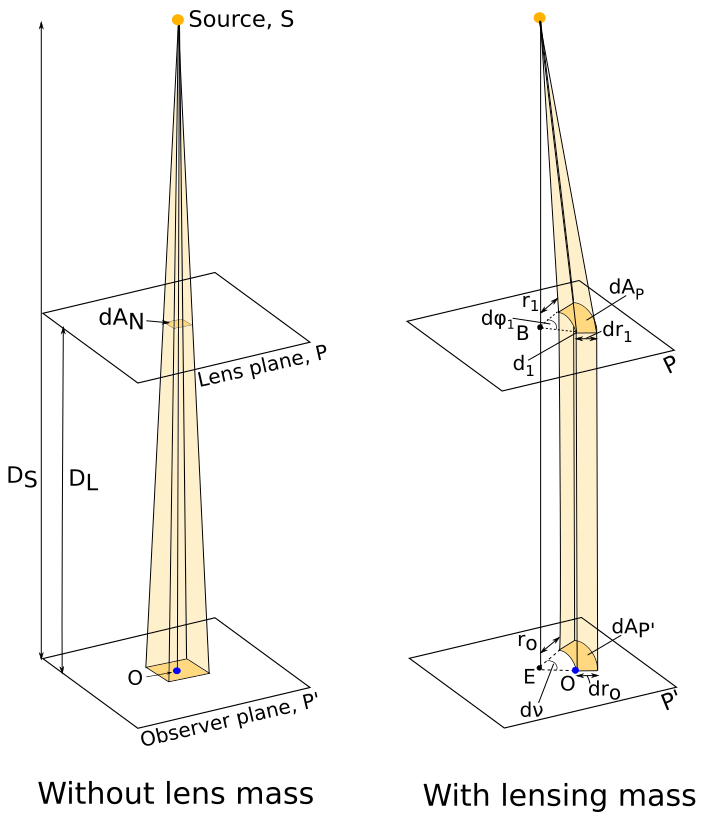
by Rachel Street
Previously, we have concluded that current telescopes cannot resolve the two images formed during a PSPL event. Notice how there is no wavelength dependence in the lensing equation - microlensing affects all frequencies of light equally, unlike most forms of intrinsic stellar variability. So what can we observe? Here we examine the effect on the intensity of the light reaching the observer.
Look at Figure 3 and imagine a bundle of light rays leaving the source, only to be deflected from their paths by the lensing mass into two images. We can describe the appearance of these images as if projected onto two planes - one at the level of the observer, P' and one at the distance of the lens, P.

| $$A = \frac{\Delta\Omega}{(\Delta\Omega)_{0}}$$ | [15] |
The relationship between ΔΩ and (ΔΩ)0, the distortion of the image area, is described by the lens equation:
| $$A^{-1} = \frac{(\Delta\Omega)_{0}}{\Delta\Omega} = \left|det\frac{d \alpha}{d \theta} \right| = \frac{d A_{P^{\prime}}}{d A_{P}} \left( \frac{D_{L}}{D_{S}} \right)^{2}$$ | [16] |
| $$d A_{P^{\prime}} = \frac{1}{2}r_{0}d\nu = \frac{1}{2}D_{L}\alpha d\nu$$ | [17a] |
| $$d A_{P} = \frac{1}{2}r d\phi = \frac{1}{2}D_{L}\theta d \phi$$ | [17b] |
since r0 = DLα and r = DLθ and dν = dφ by symmetry. So
| $$\frac{d A_{P^{\prime}}}{d A_{P}} = \frac{\theta}{\alpha}$$ |
Therefore, from [16]:
| $$\left|det\frac{d\alpha}{d\theta}\right| = \frac{d A_{P^{\prime}}}{d A_{P}}\left( \frac{D_{L}}{D_{S}} \right)^{2} = \frac{\theta}{\alpha}\left(\frac{D_{L}}{D_{S}}\right)^{2} = A^{-1}$$ | [18] |
| $$A = \left|\frac{\theta_{\pm}d\theta_{\pm}}{\alpha d\alpha} \right|$$ | [19] |
θ∓ is of course given by the solutions to the lens equation, from which we can also derive dθ∓/dα:
| $$A = \frac{\theta}{2 \alpha} \left( 1 + \frac{\alpha}{\sqrt{\alpha^{2} + 4\theta_{0}^{2}}} \right)$$ | [20] |
For simplicity, we define u:
| $$u = \frac{\alpha}{\theta_{0}} = \frac{\alpha}{\sqrt{\frac{4GM_{L}}{\mu D_{L}c^{2}}}}$$ | [21] |
Using this, we re-write the solutions to the lens equation as:
| $$\theta_{\pm} = \frac{u\pm\sqrt{u^{2}+4}}{2}\theta_{0}$$ | [22] |
We can now write an expression for the magnification in terms of the angular separation of lens and source:
| $$A_{\pm} = \frac{\theta}{2\alpha}\left(1 + \frac{u}{\sqrt{u^{2} + 4}}\right)$$ | |
| $$A_{\pm} = \pm\frac{1}{2}+\frac{u^{2} + 2}{2u \sqrt{u^{2}+4}}$$ | [23] |
The total magnification during an event is simply the sum of the magnification of both images:
| $$A_{\rm tot} = \frac{u^{2}+2}{u\sqrt{u^{2} + 4}}$$ | [24] |
So for a PSPL event, of given lens mass and lens and source distances, the magnification at any given time depends on the angular separation of source and lens.
For further discussion of this, see Refsdal, S. (1964).
Let's look again at our example microlensing event, where ML = 0.4M☉, DL=4kpc and DS=8kpc, and let's say that the relative angular motion between the two is 0.1 milli-arcsec / day. Using our usual lens-centered geometry, we take the lens to be stationary and the source to be moving along a trajectory behind it. Consider 4 trajectories, which pass the lens at progressively smaller closest-approach separations.
Over a 30d period, calculate the angular separations of lens-source for each day on each trajectory. Plot the lightcurve of the source for each trajectory in terms of the magnification.